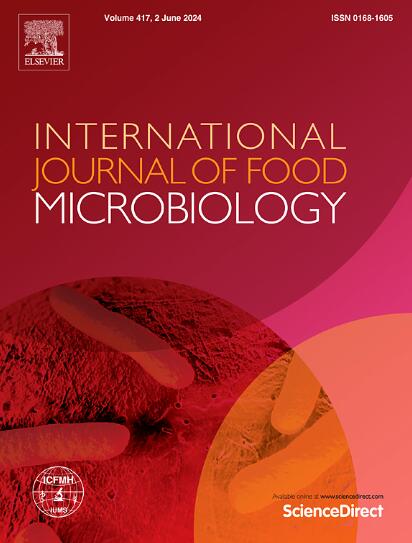LtrA is critical for biofilm formation and colonization of Vibrio parahaemolyticus on food-related surfaces
IF 5
1区 农林科学
Q1 FOOD SCIENCE & TECHNOLOGY
International journal of food microbiology
Pub Date : 2025-06-24
DOI:10.1016/j.ijfoodmicro.2025.111327
引用次数: 0
Abstract
Vibrio parahaemolyticus is the leading causative agent of seafood-associated acute gastroenteritis. The formation of biofilms is one of the key reasons for its resistance to adverse environments and its persistence in seafood. Investigating the regulatory mechanisms of biofilm formation is beneficial for the development of new intervention methods to reduce V. parahaemolyticus contamination during seafood processing and storage. In this study, we identified a global regulator, LtrA (VPA0519), which is involved in regulating biofilm formation in V. parahaemolyticus. The deletion of ltrA led to a significant alteration in the transcription levels of 706 genes, including those associated with type III and VI secretion systems and biofilm formation. LtrA positively regulated biofilm formation by enhancing the production of exopolysaccharides, extracellular proteins, extracellular DNA, and cyclic di-GMP (c-di-GMP), as well as by decreasing swimming and swarming motility. The deletion of the ltrA gene also led to a reduction in the metabolic activity of biofilm cells but did not affect the production of capsular polysaccharide. Furthermore, the deletion of the ltrA gene resulted in a decrease in the biofilm formation ability of V. parahaemolyticus on the surfaces of shrimp (Parapenaeopsis hardwickii), crab (Portunus trituberculatus), polypropylene plastic, glass, and stainless steel. The findings in this study extend our understanding of the roles of LtrA and the genetic determinants involved in biofilm formation by V. parahaemolyticus.
LtrA对于副溶血性弧菌在食物表面的生物膜形成和定植至关重要
副溶血性弧菌是与海鲜有关的急性胃肠炎的主要病原体。生物膜的形成是其在海产品中抵抗恶劣环境并持续存在的关键原因之一。研究生物膜形成的调控机制有助于开发新的干预方法,以减少海产品加工和储存过程中副溶血性弧菌的污染。在这项研究中,我们发现了一个全局调节因子LtrA (VPA0519),它参与调节副溶血性弧菌的生物膜形成。ltrA的缺失导致706个基因的转录水平显著改变,包括与III型和VI型分泌系统和生物膜形成相关的基因。LtrA通过促进胞外多糖、胞外蛋白、胞外DNA和环二gmp (c-di-GMP)的产生,以及通过降低游动和群体运动,积极调节生物膜的形成。ltrA基因的缺失也导致生物膜细胞的代谢活性降低,但不影响荚膜多糖的产生。ltrA基因的缺失导致副溶血性弧菌在对虾(Parapenaeopsis hardwickii)、蟹(Portunus trituberculatus)、聚丙烯塑料、玻璃和不锈钢表面形成生物膜的能力下降。本研究的发现扩展了我们对LtrA的作用和参与副溶血性弧菌生物膜形成的遗传决定因素的理解。
本文章由计算机程序翻译,如有差异,请以英文原文为准。
求助全文
约1分钟内获得全文
求助全文
来源期刊
CiteScore
10.40
自引率
5.60%
发文量
322
审稿时长
65 days
期刊介绍:
The International Journal of Food Microbiology publishes papers dealing with all aspects of food microbiology. Articles must present information that is novel, has high impact and interest, and is of high scientific quality. They should provide scientific or technological advancement in the specific field of interest of the journal and enhance its strong international reputation. Preliminary or confirmatory results as well as contributions not strictly related to food microbiology will not be considered for publication.

 求助内容:
求助内容: 应助结果提醒方式:
应助结果提醒方式:


